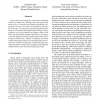Free Online Productivity Tools
i2Speak
i2Symbol
i2OCR
iTex2Img
iWeb2Print
iWeb2Shot
i2Type
iPdf2Split
iPdf2Merge
i2Bopomofo
i2Arabic
i2Style
i2Image
i2PDF
iLatex2Rtf
Sci2ools
RECONFIG
2008
IEEE
2008
IEEE
Fast Implementation of a Bio-inspired Model for Decentralized Gathering
In the context of the emergence of alternative computing resources to address the challenge of the upcoming end of Moore’s law, we consider the feasibility of gathering computational resources by means of decentralized and simple local rules. We study such decentralized gathering by means of a stochastic model inspired from biology: the aggregation of the Dictyostelium discoideum cellular slime mold. The environment transmits information according to a reaction-diffusion mechanism and the agents move by following excitation fronts. Despite its simplicity this model exhibits interesting properties of self-organisation and robustness to obstacles. In this paper we study the major challenges that must be solved when designing a fast embedded implementation of the decentralized gathering model.
Decentralized Gathering | Decentralized Gathering Model | Discoideum Cellular Slime | RECONFIG 2008 | Reconfigurable Computing |
| Added | 01 Jun 2010 |
| Updated | 01 Jun 2010 |
| Type | Conference |
| Year | 2008 |
| Where | RECONFIG |
| Authors | Bernard Girau, Cesar Torres-Huitzil |
Comments (0)

